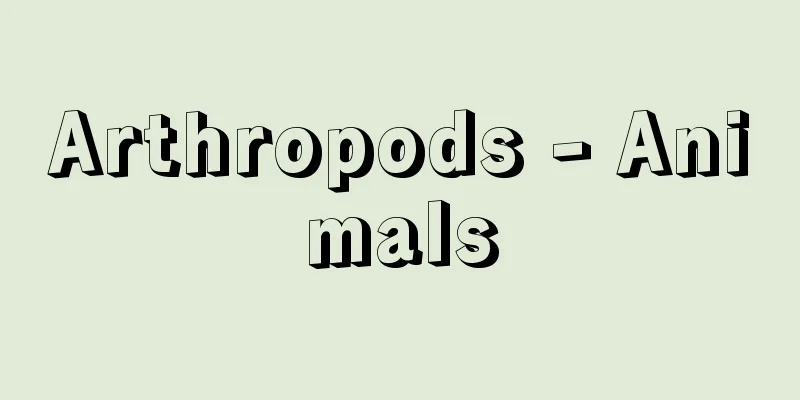Arthropods - Animals

|
In animal taxonomy, this group of animals is classified as one phylum, Arthropoda. It is a large group consisting of crustaceans such as shrimp and crabs, arachnids such as spiders and mites, and a huge number of insect species, and, along with vertebrates, they are widely distributed and thrive in all environments on Earth. It is said to be the most diverse of all animal phyla, with over 800,000 species, accounting for three-quarters of all animals. They have strong vitality and reproductive power, and have a remarkably large population. [Masamichi Takeda] systemThe body is composed of bilaterally symmetrical segments, and each segment generally has a pair of appendages. The fact that they are composed of many segments makes them closely related to the phylum Annelida, which includes earthworms and lugworms. However, whereas annelids have segments of almost the same structure lined up (homoregular segmentation), arthropods have different segments with different structures and functions depending on the part of the body (heterorthic segmentation). The body is often divided into three parts: head, thorax, and abdomen, but can also be differentiated into the cephalothorax and abdomen, or the anterior and posterior abdomen. The body surface is made of chitin and an exoskeleton that mainly contains calcium carbonate. To allow the body to bend and stretch freely, each segment is connected by a soft intersegmental membrane. The number of segments ranges from 8 to 180, but fusion of segments often occurs. An extreme example is the diplopods (millipedes), which have two segments fused together, with two pairs of walking legs appearing from each segment. The head is theoretically composed of six segments. The first segment lacks appendages and has eyes on the back. The appendages of the second segment are antennae, and those of the third segment become second antennae only in crustaceans, but degenerate in insects, chelicerae (centipedes) and diplopods, and become pincer-like chelicerae in arachnids (spiders). The appendages of the fourth segment differentiate into mandibles in arachnids and mandibles in all others, which serve to chew food. The appendages of the fifth and sixth segments are generally the first and second mandibles that assist in feeding, but in arachnids they become the first and second walking legs. The eyes on the head are simple and compound eyes, which may coexist. There is a single simple eye on the midline, or a pair on either side of the midline, and they primarily sense light and dark. Compound eyes, a structure unique to arthropods, are generally well developed, but in animals with specialized ecology they have secondarily degenerated. There is a pair of compound eyes located on the sides of the head. They consist of a collection of many individual eyes that form a mosaic image, but are particularly sensitive to the movement of objects, and it has been experimentally confirmed that higher animal groups also have color vision and can recognize direction and distance. The number and shape of trunk appendages vary widely among animal groups. They are basically organs of locomotion, but insects always have three pairs, arachnids four pairs, and diplopods two pairs per segment. The abdomens of insects and arachnids are limbless, but vestiges can be seen in the embryonic stage, and the reproductive organs of insects and the spindle organs of arachnids are thought to be modified appendages. The appendages of crustaceans are bifurcated, retaining the original form of appendages, but the bifurcated form is more suitable for swimming than walking. The skin or exoskeleton that covers the surface of the body has developed spines, projections, bristles, and soft hairs to protect the body, but insects have two pairs of wings that are an extension of the body wall and serve as a unique organ of locomotion. [Masamichi Takeda] Internal OrgansThe digestive tract begins with the mouth and ends with the anus, which is surrounded by mouthparts derived from the upper lip, maxilla, lower lip, maxillae, or appendages such as the chelicerae and maxillae. The mouth is followed by the mortar, gizzard, and pyloric stomach, and then the midgut, which has dentate bodies on its inner wall that aid in mechanical digestion. The midgut is accompanied by a blind pouch, which branches in a complex manner to serve the functions of digestion, absorption, and storage of nutrients, and is therefore specifically called the hepatopancreas. The hindgut, which follows the midgut, often also has dilations and accessory glands. The muscles are well developed, and most are striated muscles suited to explosive motor functions, but only the intestine and blood vessels are surrounded by a smooth muscle layer with excellent durability. Respiratory organs are gills in aquatic species, and tracheas or their differentiated lungs in terrestrial species. Gills originate from the body wall and branch into thread-like, leaf-like, and root-like structures to increase the surface area. The trachea seen in insects is a tubular invagination of the body wall that branches into a mesh-like pattern and spreads between various internal organs, and the main tube is connected to the outside world by spiracles at each body segment. The lungs are a structure unique to arachnids, and consist of a thin leaf structure stacked on top of an invagination on the ventral surface. It has an open vascular system, and the blood vessels are not well developed. Generally, the tubular heart with an ostium for each segment becomes shorter in more advanced organisms, with only one or two pairs of ostium. The peripheral parts of the blood vessels connect to tissue spaces, and the venous blood that passes through them flows to the gills, becomes arterial blood, and returns to the pericardial cavity that surrounds the heart, or exchanges gases directly with the air that flows into the trachea. The respiratory hemocyte is generally hemocyanin. Excretory organs are a modification of the segmented organs of annelids, with the number reduced to one or two pairs. Examples of excretory organs include the antennal glands and mandibular glands of crustaceans. The excretory organ unique to arthropods is the Malpighian tubule, which develops at the junction between the midgut and hindgut of insects and arachnids. It is clear that the nervous system also originated from the ladder-like nerves of annelids, but as the body structure becomes more complex, the left and right ganglia become closely attached and centralization also occurs at the front and back. In general, the nervous system is well developed, and in addition to the central nervous system that controls perception and movement, the sympathetic nervous system is also well developed. [Masamichi Takeda] Reproduction and DevelopmentGenerally, they are dioecious, with secondary sexual characteristics developing in body size, body color, and the shape of appendages. Some epiphytic or parasitic organisms are hermaphroditic, and some undergo sex reversal and parthenogenesis. Alternations between hermaphroditism and parthenogenesis occur in insects and crustaceans, and sometimes parthenogenesis is common because males are rare. In those with well-developed genitalia, the sexual instinct may be highly developed, and courtship and other complex processes may take place before mating is complete. They are usually oviparous, hatching as larvae or nymphs, which undergo metamorphosis into adult form. In most cases, the eggs are yolk-centered, with the yolk in the center, and development progresses by cleavage. Ovoviviparity and viviparity are also observed, as are examples of larval reproduction, larval maturation, and polyembryony. There are stages in the care of the young, ranging from simple egg laying to preparations in which food is readily available for the hatched larvae. The mother may provide some protection, and in social insects, sterile females store and provide food for the larvae. [Masamichi Takeda] ClassificationAn ancient form of arthropods, called trilobites, appeared in the Cambrian Period of the Paleozoic Era, but insects appeared in the Devonian Period of the Paleozoic Era and flourished with the increase in land area and the evolution of plants from the Mesozoic Era to the Cenozoic Era. The Arthropoda phylum is currently divided into the following 10 classes: (1) Trilobita: fossils only. (2) Pycnogonida: also known as Pantopoda. (3) Xiphosura: also known as Merostomata. Horseshoe crabs, of which only four species are extant. (4) Arachnida: spiders, scorpions, mites, etc. (5) Crustacea: water fleas, sea lice, shrimps, crabs, etc. (6) Symphyla: a small group represented by the giant worm. (7) Paulopoda: a small group represented by the Japanese garden worm. (8) Diplopoda: millipedes. (9) Chilopoda: centipedes, house centipedes, etc. (10) Insecta: a large group consisting of dragonflies, grasshoppers, butterflies, bees, beetles, etc. [Masamichi Takeda] EcologyFrom the polar regions to the tropics, from the deep sea to the high mountains, arthropods inhabit every environment on earth, each of which has been skillfully adapted to its own environment. The diversity of environments has led to a diversity of movements, including walking, running, crawling, jumping, flying, and swimming, as well as an astonishing diversity in feeding habits and lifestyles. Methods of attack and defense have also been well developed, with protective and warning coloration, camouflage, and death feigning behavior, as well as noteworthy behaviors such as crustaceans with pincer appendages, arachnids that attack with venom glands and stingers, and insects. The development of sociality seen in insects is an ecological characteristic not seen in other invertebrates. [Masamichi Takeda] Source: Shogakukan Encyclopedia Nipponica About Encyclopedia Nipponica Information | Legend |
|
動物分類学上、一つの門Arthropodaとしてまとめられる動物群。エビやカニなどの甲殻類、クモやダニなどのクモ形類、膨大な種数の昆虫類などからなる大きな群で、脊椎(せきつい)動物と並んで地球上のあらゆる環境に広く分布して栄えている。全動物門のなかでもっとも種類が多く、全動物の4分の3で80万種以上といわれている。生活力も繁殖力も強く、個体数も著しく多い。 [武田正倫] 体制体は左右相称の体節からなり、各節に付属肢が1対ずつつくのが原則である。多数の体節からなる点はミミズやゴカイなどを含む環形動物門と類縁が深いが、環形動物ではほぼ同じ構造の体節が並んでいるのに対し(同規的体節制)、節足動物では体の部位によって体節の構造や機能が異なる(異規的体節制)。体は、頭、胸、腹の3部に分かれていることが多いが、頭胸部と腹部あるいは前腹部と後腹部などに分化する。体表にキチン質と、これに主として炭酸カルシウムを含んだ外骨格が発達している。体の屈伸を自由にするために、各体節は軟らかい節間膜でつながっている。体節数は8~180の幅があるが、体節の癒合がしばしばおこり、極端な例として、2節ずつ癒合して見かけ上1節から2対の歩脚が出ている倍脚類(ヤスデ類)があげられる。頭部は理論上6節からなる。第1節は付属肢を欠き、背面に目をもつ。第2節の付属肢は触角、第3節の付属肢は甲殻類に限って第2触角となるが、昆虫類や唇脚類(ムカデ類)、倍脚類などでは退化し、クモ形類(クモ類)でははさみ状の鋏角(きょうかく)となる。第4節の付属肢は、クモ形類は脚鬚(きゃくしゅ)、ほかはすべて大あごに分化し、食物をかみ砕く役目をする。第5、第6節の付属肢は一般に摂餌(せつじ)の補助をする第1、第2小あごであるが、クモ形類では第1、第2歩脚となる。 頭部にある目は単眼と複眼で、共存することもある。単眼は正中線上に1個、あるいは正中線の左右に対(つい)をなして存在し、主として明暗を感受する。節足動物固有の構造である複眼は一般によく発達するが、特殊な生態をもつものでは二次的に退化している。複眼は1対で、頭部側面に位置する。多数の個眼の集合からなり、モザイク像を結ぶが、物の動きにはとくに敏感で、高等な動物群では色覚もあり、方向や距離の認識もできることが実験的に確認されている。 胴部付属肢の数および形態は動物群ごとに多様に変化する。それらは基本的には運動器官であるが、昆虫類ではつねに3対、クモ形類では4対、倍脚類では各節2対ずつである。昆虫類やクモ形類の腹部は無肢であるが、胚(はい)期には痕跡(こんせき)がみられ、また昆虫類の生殖器、クモ形類の紡錘器は付属肢の変形と考えられる。甲殻類の付属肢は二叉(にさ)型で、付属肢の原型をとどめているが、二叉型は歩行よりも遊泳に適した形態である。 体表を覆う外皮あるいは外骨格からは、棘(とげ)、突起、剛毛、柔毛などが発達して身を守るが、昆虫類では体壁の伸長に由来する2対のはねがあり、特異な運動器官となっている。 [武田正倫] 体内器官消化管は口に始まり、肛門(こうもん)に終わるが、口は上唇、大あご、下唇、小あご、あるいは鋏角や顎脚(がっきゃく)など付属肢に由来する口器に囲まれている。口に続いて胃臼(いきゅう)、砂嚢(さのう)、幽門胃を経て中腸に続くが、胃臼には内壁に歯状体があり、機械的消化を助ける。中腸には盲嚢が付属しており、複雑に分枝して消化、吸収、栄養分の貯蔵の役をするため、とくに肝膵臓(かんすいぞう)とよばれる。中腸に続く後腸もしばしば拡張部や付属腺(せん)を備える。筋肉はよく発達し、ほとんどは瞬発的な運動機能に適した横紋筋であるが、腸管と血管のみは持続性に優れた平滑筋層に囲まれている。 呼吸器官は、水中生活種ではえら、陸上生活種は気管またはその分化した書肺である。えらは体壁に由来し、糸状、葉状、根状に分枝して表面積を広げている。昆虫類にみられる気管は、体壁が管状に陥入したものが網目状に分枝して体内諸器官の間に広がったもので、主管は体節ごとに気門によって外界に通じている。書肺はクモ形類に特有の構造で、腹面の陥入部に薄葉構造が積み重なったものである。 開放血管系で、血管の発達はよくない。一般に体節ごとに心門を備える管状の心臓は高等なものほど短縮し、心門は1、2対になってしまう。血管の末梢(まっしょう)部は組織間隙(かんげき)に通じているが、そこを通過した静脈血はえらに流れて動脈血になって心臓を包む囲心腔(こう)に帰り、あるいは気管に流入する空気との間に直接ガス交換を行う。呼吸血素は一般にヘモシアニンである。 排出器官は環形動物の体節器官の変形で、その数は1、2対に減っている。甲殻類の触角腺や小あご腺がこれにあたる。節足動物固有の排出器官は昆虫類とクモ形類の中腸と後腸の境に発達するマルピーギ管である。 神経系も環形動物の梯(てい)状神経に起源をもつことは明らかであるが、体制が複雑になるとともに左右の神経節が密着し、また前後の集中化もおこってくる。一般に神経系の発達はよく、知覚や運動をつかさどる中枢神経系のほか、交感神経系も発達している。 [武田正倫] 生殖・発生一般に雌雄異体で、体の大きさ、体色、付属肢の形などに二次性徴が発達する。着生生活や寄生生活をするものには雌雄同体もあり、また性転換や単為生殖をするものもみられる。両性生殖と単為生殖の交代は昆虫類と甲殻類に存在し、ときには雄がまれであるために単為生殖が普通であるものもある。 交尾器が発達するものでは性本能が著しく発達していることがあり、交尾完了までに求愛そのほか複雑な過程を経ることがある。通常、卵生で、幼虫、幼生の形で孵化(ふか)し、変態して成体形になる。卵は多くの場合、卵黄が中心にある心黄卵で、表割により発生が進行する。卵胎生や胎生もみられ、幼生生殖、幼体成熟、多胚現象の例もみられる。保育には段階があり、放卵にすぎない場合から、孵化幼虫がすぐ食物を得ることができるように準備がなされる場合までいろいろである。母体がある程度保護することもあり、社会性昆虫類では生殖不能の雌が幼虫のために食物を蓄えて与える。 [武田正倫] 分類節足動物の古い形のものは三葉虫類として古生代カンブリア紀にすでに出現しているが、昆虫類は古生代デボン紀になって出現し、中生代から新生代にかけて陸地の増加と植物の進化とともに栄えてきた。節足動物門は、現在、次の10綱に分類されている。 (1)三葉虫綱Trilobita 化石のみ。(2)ウミグモ綱Pycnogonida 皆脚綱Pantopodaともよばれる。(3)剣尾綱Xiphosura 節口綱Merostomataともよばれる。カブトガニ類で、現生するのは4種のみ。(4)クモ形綱Arachnida クモ、サソリ、ダニなど。(5)甲殻綱Crustacea ミジンコ、フナムシ、エビ、カニなど。(6)結合綱Symphyla ナミコムカデに代表される小群。(7)少脚綱Paulopoda ニワヤスデモドキに代表される小群。(8)倍脚綱Diplopoda ヤスデ類。(9)唇脚綱Chilopoda ムカデ、ゲジなど。(10)昆虫綱Insecta トンボ、バッタ、チョウ、ハチ、甲虫類などからなる大群。 [武田正倫] 生態極地から熱帯、深海から高山まで地球上のあらゆる環境に、それぞれ巧みに適応した節足動物が生息している。環境の多様性は、歩く、走る、はう、跳ぶ、飛ぶ、泳ぐ、など運動の多様性をもたらし、また食性や生活様式の多様化も驚くほどである。攻撃や防御の方法もよく発達し、保護色や警告色、擬態や擬死などの習性のほか、付属肢がはさみとなる甲殻類、毒腺や毒針で攻撃するクモ形類、昆虫類などは注目に値する。また、昆虫類にみられる社会性の発達は、ほかの無脊椎動物にはみられない生態的特性である。 [武田正倫] 出典 小学館 日本大百科全書(ニッポニカ)日本大百科全書(ニッポニカ)について 情報 | 凡例 |
Recommend
Han-shan Shi-de (English spelling)
Two legendary poet-monks from the Tang Dynasty in ...
Oi - Hey
Synonymous with "carry". A tool to carr...
Nationalization (English spelling)
The transfer of non-state property, including pri...
Mixing test - Konyu Shiken
A method to confirm whether two solid organic com...
Function - Kansuu (English) function
In the past, this was written as "function.&...
Urushibe Tsukasa - Urushibe no Tsukasa
This was one of the government offices under the R...
Engine braking
〘Noun〙 ( English: engine brake) When a car is goin...
Reichsbank
Germany's central bank until the end of World ...
Supervisor - Gen
〘Noun〙① Special administrative districts establish...
Iwakuni Castle Town
…In 1975, the Shinkansen Shin-Iwakuni Station was...
Manuel Estrada Cabrera
1857‐1924 Guatemalan politician and dictator. He s...
Technological process
In a broad sense, production can refer to self-su...
Juran Hisao
Novelist and playwright. His real name was Abe Ma...
Okutama
Located in the western part of Tokyo, in the uppe...
Three Temples of Hezhou
...As a result of the Chokyo Rebellion, the Kaga ...









